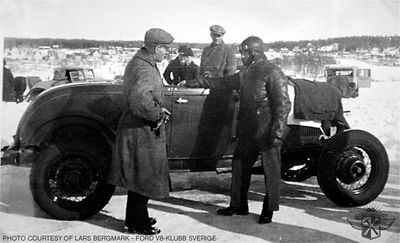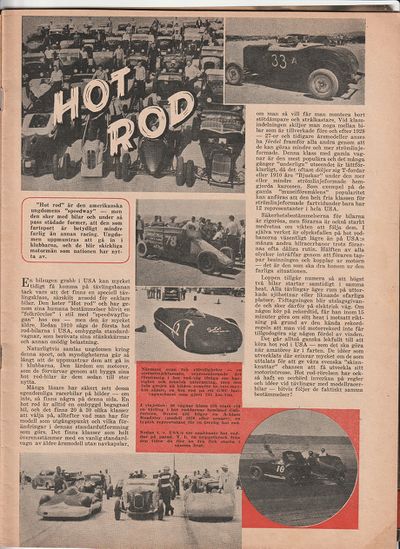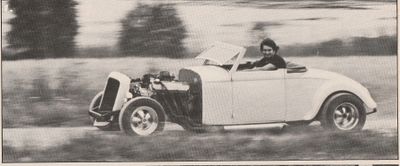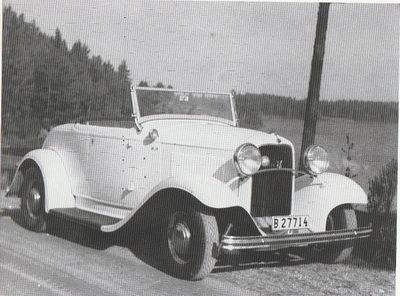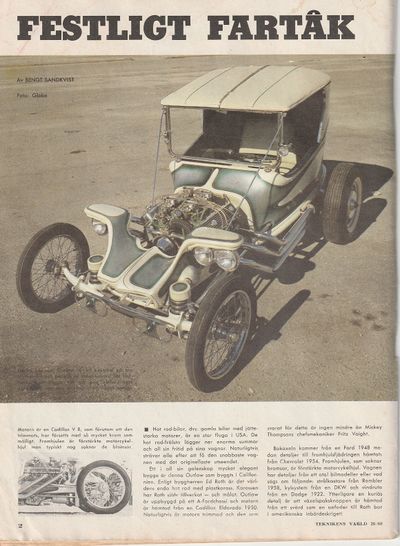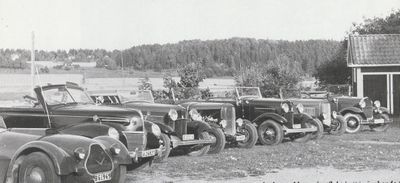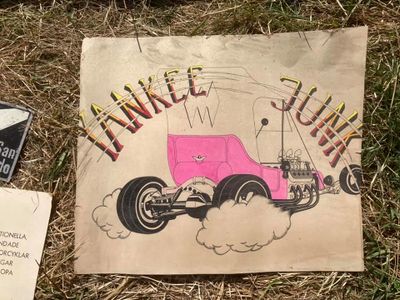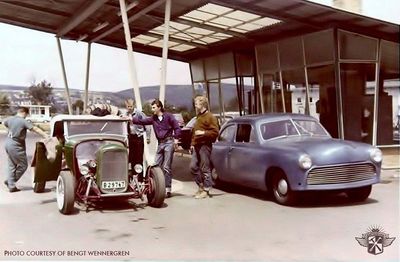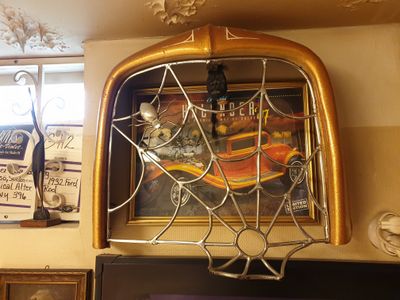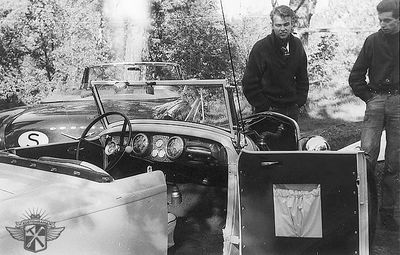Swedish Hot Rod history (between 1945-1965)
This is a slightly modified and translated version of articles written by Mats Wallander, published in two issues of SSRA members magazine ”Street Rod Bladet” 2021.
No links to Kustomrama articles are included but you can use the Search field to find more information.
Contents
- 1 Part 1 1930-1960
- 1.1 Early times
- 1.2 Inspiration from the United States where racing activities were in full swing.
- 1.3 In Sweden
- 1.4 Then came the big youth revolt of the 1950s!
- 1.5 Stock-Car
- 1.6 "Klinten"
- 1.7 Sollentuna
- 1.8 Newer power plants and further modifications
- 1.9 What happened to these very first Swedish Hot Rods?
- 2 Part 2 1960-1965
Part 1 1930-1960
Early times
What was it that made Sweden to develop such a strong and innovative car and motorcycle culture? When did Hot rodding come to Sweden? Who / what was first?
You need to delimit certain periods so we thought we would start by trying to describe the period after the Second World War 1945 until 1960 when a lot happened.
But even before the Second World War, there were many talented Swedes who built and raced with rebuilt stripped Fords and other American cars in Grand-Prix competitions on ice at e.g. lake Rämen at Borlänge.
Names like Olle Bännström, Gottfried Darck, Hans Osterman and others contributed to the development and sales. Imported cars were already rebuilt in the assembly workshops for racing.
Swedish engineering has always been strong since the 19th century and it has lived on in future generations. In the thirties, Sweden had a fairly large import of American cars. Then came the war with petrol rationing, gas-driven vehicles, etc. On the farms, you took what was available was collected to cover agriculture and transport. EPA tractors became a concept. Car junk-yards didn’t exist yet. There was a natural break of 6-7 years until the world began to recover in 1945 - 1946 and new cars were produced.
Inspiration from the United States where racing activities were in full swing.
We found a fun early article from Motormännen's magazine 'Motor' in May 1945 (!) About a young guy Mr. Richard Ford, who was temporarily stationed in Sweden, would return to California after WW2. In his wallet, he had pictures of cars competing for the Southern California Timing Association SCTA on dehydrated salt deserts. His club had 300 members and every weekend the otherwise street-driven cars were modified to break speed records. His own car was built on a Hudson chassis and had sharpened Ford V8.
There are different opinions about how the term 'Hot Rod' came about. In the United States, tuned cars were often referred to as "gow jobs". Most people agree that 'to Hot' means to trim or improve something. 'Rod' can come from either 'Roadster', which was a common model to start from, or 'Rod' in the term 'connecting rod' or 'camshaft' <reference Wikipedia>. Scholars still argue about that today.
Hot Rod Magazine was started in January 1948 and this magazine would also be distributed to Sweden eventually. So, it was all about going as fast as possible! One purpose was to be able to drive away from the police when alcohol was smuggled from neighboring states or Canada.
In Sweden
But what happened in Sweden during the first half of the 1950s? Due to our neutrality during the war, we had done well and were able to build a strong industry and society with "people's homes" and social welfare. Much was glanced west towards the United States, new space technology and faith in the future.
Swedish newspapers naturally monitored technological developments in the United States. In Teknik för Alla 1952 there is an article about Hot Rods in the USA which still touched on the sport / hobby that would later become Dragracing. The NHRA National Hot Rod Association was formed in May 1951. <Article 2> from TfA 1952.
In 1954, Teknikens Värld also drew attention to the "Hot rod" of young people's progress in the USA and saw great potential for both Sweden's car industry and youth care! Even though it may not have been off-road driving you did.
We know that there were very knowledgeable motorists by tradition on the farms around the country. In old "pilsner movies" some cars can be seen and of course we have Åsa-Nisse's Eulalia II which existed both as a Chevrolet and a Ford B in 1932. "Vedbod trimmer" became a concept that still stands today. They simply took what was available nearby and fixed it to something drivable.
Then came the big youth revolt of the 1950s!
Movies, music and magazines that flowed in from the USA and which formed a completely new liberated and revolting youth culture with associated cars - "Dollargrin".
Living Dangerously and Dying Young was the message with idols like James Dean, Marlon Brando, Lee Marvin on the big screen and Elvis rock'n'roll. "Knutten" and "Raggaren" became concepts. They gathered at a café, drank Coca-Cola & Loranga and played on the jukebox.
For those of us who are now "in the upper middle age", it was our parents who were in the 50s in Sweden when the foundations for Hot Rod and Custom were laid. There is much more to tell about Raggare and Knuttar, but here we will focus on those who were tuning and modifying the pre-war cars they found (Hot Rods).
Stock-Car
Even around Sweden, these competitions were run in the middle of the 50's, which were somewhat reminiscent of those in the USA. The rules were simple; Car older than 10 years and weight under two tons. Then it was a matter of getting to the finish line first after a few laps on a speedway track. Many pre-war cars - mostly American, unfortunately broke down when carriages collided and overturned wildly, which was allowed. The drivers received extra compensation the more spectacular they drove! The cars at that time had no value but much went to the scrap. This "sport" fortunately ebbed away after a few years.
Former SSRA president Olle Thorslund was around 1972 and looked at a Ford 1936 coupe former Stock-Car in Uppland around. However, the body was so battered that it could not be saved.
"Klinten"
The first known car, known to us, which could be called 'Hot Rod' is Lars Jonsson's Nash from 1933. Lars lived on the farm 'Klinten' in Delsbo and won the car in card games at a fiddlers' meeting!
(Delsbo is known for regular meetings and concerts for folk music fiddlers).
He modified the car with a front and rear car from a Hudson, a frame from Chevrolet, fenders from Citroën and a grill from a Chrysler. The windshield was angled down. The straight side valve six remained but was tuned slightly. The car was a real gasser on the local narrow roads around Delsbo in 1952-1954, all to the local sheriff's despair!
What inspired Lars was probably more his own interest and to take advantage of old "scrap" rather than influences and magazines from the US.
The car was never registered so it was put away when Lars started a family. It ended up in a barn for many years until his son Gunnar Jonsson took it over in the late 60's, renovated and put in a 429 "CJ engine.
The now 70-year-old Hot Rod is still alive with the same old "Klinten-Gunnar" behind the wheel. Gunnar is now considering getting it approved via SFRO, as the rules have changed!
Is this car Sweden's first and oldest Hot Rod? We put a penny on it… Feel free to contact us if you know anything else!
Sollentuna
On Alvägen in Edsviken in Sollentuna north of Stockholm, there was a young man in 1955 who worked with his newly purchased Ford 1932 Roadster outside his father's car workshop. Lennart Djurberg was the name, and he would become one of the leading figures in Swedish Hot rodding. The car interest came from racing competitions at Skarpnäck during the early 1950s. 'Nordic special car class' with home-tuned pre-war cars from all over Sweden were popular. The Fords was the fastest, so a 1932 Roadster was purchased by Lennart for SEK 325. Good advice came from his father, who has long been involved with cars: - "Take a light Ford Roadster and install a tuned 100-horsepower engine and you will have the fastest car!"
Around Djurberg's workshop, more young people interested in motoring would appear and an informal gang was formed where they peppered and supported each other.
At this time, many movies from the United States were shown at local cinemas. Many including a motor theme. The "raggar culture" grew with cars like post-war Fords (46-48) and Mercurys. Hot Rod Magazine and other motoring magazines were available for purchase at e.g. Foreign press on Banhusgatan, Stockholm.
One late evening around 1957, Lennart was a turn into Stockholm and then saw an A-Ford vehicle that was lowered, had exposed screens and chrome details on the engine. The owner's name was Peder Lundgren and he had received influences directly from the USA.
Together with his friend Peter Billing from Lidingö, the three became the core of an ever-larger circle with tuned 30s Fords as an interest. Lundgren acquired an A-Ford Roadster which was placed on -32a frame and Billing found a -32a cab in Stuvsta south of Stockholm. Later, the brothers Jan and Björn Bellander from Gustavsberg joined, as well as the brothers Ronny and Janne Eriksson who lived near Djurbergs on Alvägen in Sollentuna. Roland Larsson from Värmland also joined the gang with a 1936 Ford cabriolet. "Norrtälje-Bosse" with a -32 Roadster and a wild youth from Huddinge - Lars Ljungkvist called "Junken" with a -32 Tudor. There were also some Ockelbo / Ford in the gang.
Together, it was 10-12 "real" Hot Rods who went on excursions and gassed well on the roads around Stockholm.
A hot -36a cab was also part of the gang that Göran Almén bought from Djurberg.
A couple of brothers who have meant a lot are Ove and Bosse Kasby. Bosse lived in the USA and worked at Moon. Parts were sent home to order via Ove and the company BoMac in Älvsjö to the builders. In their order blocks that are preserved, many names are recognizable!
It was probably only now that they started to make sure that the cars looked pretty good. A nice paint and a little chrome on the engine were never wrong even if it cost extra. "Customizing" began to become a concept even in raggar circles, attracted more girls perhaps?
Newer power plants and further modifications
The tuned Ford side valves soon faced competition from the new overhead valve engines. Probably an Oldsmobile Rocket engine (which began to be manufactured as early as 1949) ended up in a car before the Chevrolet's 265 V8 became available. It should be borne in mind that many of the cars imported from the USA often had a cheaper engine alternative. Peter Billing was probably the first in Sweden to put in a 150 horsepower 265 Chevrolet engine in his 1932 cab in 1959. The engine came from Germany via a friend. Peter's brother Göran also put in a similar engine in his 5-window coupe. The Kasby brothers had a T-Ford touring body placed on a -32 chassis. This also got a Chevrolet 265 V8 with imported things such as three-carburetor suction, Corvette valve covers and headers. Unfortunately, we have never seen a photo of this car and do not know where it went! More tricks were done on the cars such as putting an A-ford front beam on the frame to lower the car. Peder Lundgren and Roland Larsson were the first to lower the body over the frame (channeling) and mount free-standing front fenders from -36a spare wheel tub. The Hot rod interest steadily increased, and more constructions appeared.
The next episode will be about the period 1960 to 1965 and the first Hot Rod exhibition in Stockholm. New profiles from southern Stockholm were added to the picture.
What happened to these very first Swedish Hot Rods?
Many have disappeared but some still remain;
- • Lennart Djurberg's -32 Roadster is still in his possession.
- • Roland Larsson's lowered -32a can be found at Jan-Olof Ödahl.
- • Janne Bellander's -31a Roadster was sold to the USA.
- • Björn Bellander's -32 Roadster ended up with Benneth Landén and has now been sold by the sterbhouse.
- • Peter Billings -32a cab ended up with "Norrtälje-Bosse" who renovated. Unknown fate thereafter.
- • Norrtälje-Bosses -32a Roadster ended up in Dalarna and is now with Jörgen Fjellet.
- • Janne Eriksson's -32a Roadster is known to us now at Johan Djurberg.
- • Janne Bellander's -32a 5-win was first sold to Göran Billing, later via "Gamen" and several other owners. Since 1984, it belongs to Perry Ahlgren.
- • The "Junkens" -32a Roadster was sold to Germany in the late 1960s. Fate unknown.
- • Göran Almén's -36a cab is now owned by Kenneth Wik.
(Please see Kustomrama.com for more updated history and information)
Part 2 1960-1965
The Swedish Hot Rod story continues
A lot happened in the world in the late 1950s. The Russians sent Sputnik and the dog Laika into space. The TVs came to the homes. The American cars reached their peak of space-inspired design and there was a strong economy and faith in the future in Sweden.
Folkhemmet was built and the country developed in a scientifically and engineering-correct way. Sweden held the World Cup in 1958 and took silver, "Ingo" became heavyweight Champ in 1959! On the motor side, we had stars like Joakim Bonnier, Varg-Olle Nygren and Ove Fundin.
Swedish film "Raggare!" coming to the cinemas. The yunk-yard owner Lelle "Skägget" Andersson in Huddinge provided many cars to the Swedish Film Industry. The stock-car racing that unfortunately harvested many victims of cars from the 1930s fortunately died out due to reduced audience interest. Some of the first Hot Rod pioneers invested in track racing, such as Janne Bellander.
It is also now that the big 1940s born generation gets jobs, driving licenses, cars and motorcycles! The groups of guys interested in technology and motoring that already existed inspired others and gained more followers. Hot Rod and technology magazines were plowed through and gave ideas. Many started with MC and tuned mopeds and switched to cars.
Unfortunately, there are not so many photos or movies around our hobby from this time. Not everyone could afford cameras or filmmaking.
Southern Stockholm
In the southern Stockholm area, in the early 1960s there were many young people around the Enskede, Tyresö and Älvsjö area who found old cars to rebuild. Huddinge resident "Junken" was already on the move with his -32 Roadster and inspired his friends.
Some new names were Kjelle Gustad, Hasse Broberg, Benke Wennergren, Jonas Qvarnström, Chrille Lundberg, Palle Eriksson, Björn Wallman, Göran Silfors, Ronnie Haglund, the brothers Olle and Richard Bergström.
And of course the brothers Bo and Sven Sandberg, who grew up on Svarvargatan on Kungsholmen but with a summer place on Vendelsö where many vehicles were built in a barn.
They lived around the Enskede field but also had a garage in Trollbäcken. "Gamen" thought they should have a club name so after a bit of talk they jokingly decided on "Sillarna" or "Sill drivers"! "Sill" is translated as "Herring fish" in English!
From Road Devils to YCP
Bosse "Gamen" Sandberg had already in 1958 formed the raggar club "Road Devils" together with his friend 'Pilen' after a cinema visit. Special numbered aluminum plates were made to be hung in the rear bumper. Several ended up on the Hot Rods that existed, including Lennart Djurbergs and Janne Eriksson's -32a Roadsters.
The club was considered the wildest in the Stockholm area and created a lot of (negative) headlines in the newspapers. Eventually the club died out and raggar life lived on in other clubs such as "Car Angels" and "Teddybears" which even got clubhouses from the municipality! Some formed families and calmed down a bit for that reason.
"Gamen" focused on building Customs and Hot Rods, moved in 1962 to a house with many garages in Örby and started Yankee Custom Parts (YCP) together with his girlfriend Mette. Göran Silfors(also known as "lill-sillen ”) (also called "little herring") helped at the company. It was probably the Nordic region's first Custom shop to undertake all possible customer jobs, including candy and flake varnishes.
Objects
The range of 30s Fords began to thin out in Sweden, so many trips went to scrap metal in Denmark and Norway, where you could still find coupes or Roadsters for sensible money. You often had to "set off" the car against a Swedish car sold smaller to avoid problems with customs, etc. They simply used the number plates on the way home. If you were lucky, you could find a decent compartment for a few 100-notes.
There are many fun stories around these car-looking trips and how to transport the stuff home with homemade dollys and stuff on the roof etc.
Some cars were fully drivable but could still be bought for reasonable money.
The Huddinge barn
Around 1962, Huddinge municipality offered a larger "barn" for rent in Högmora quite close to Lelle's car scrap. This became a perfect haunt and workshop for the car builders in the area and several moved in there with their projects after a renovation of the shed that the boys did themselves.
First on site were Benke Wennergren, Ronnie Haglund, the Bergström brothers and others. Many vehicles have since been built in or passed this barn over the years. Anders Lake and Pelle Karlsson ran the "Trike factory" there in the early 1970s.
This unique place still exists and is carefully managed by Lelle's little brother Tommy Andersson. It should be K-marked soon, right?
New constructions and ideas
Although the state began with various types of car inspections at this time, energy flowed and many cars were built in barns and sheds. Now the 50's cars started to come down in price to be Customized and the supply of Hot Rod items was good. Plastic replaced tin putty and raw varnishes such as flake, pearl and candy were brought home from the USA.
Some examples:
- • "Sillarnas" 1938 Chevrolet cabr.
- • Björn Bellanders (Värmdö) 1932 Ford Roadster.
- • Benke Wennergrens 1949 Ford Custom.
- • Chrille Lundberg's 1931 Chevy Roadster and his 1937 Ford coupe.
- • Palle Eriksson's 1924 Chevrolet with Hemi engine.
- • Göran Silfors A-Ford on 32nd frame - "Early Bird".
- • Bosse "Gamens" T-23 "Purple Passion".
- • Sven Sandbergs 1932 Ford 5-win "Glowing Coupe".
- • Björn Wallmans 1932 Ford Roadster.
This car was prepared, it is still there today. It is a Ford 32 3rd window compartment. It was bought by Lennart Djurberg and made ready, the car had been behind a barn somewhere in Sweden. Otherwise, many Ford 32s were picked up in Denmark. The Ford had been allowed to serve as a hen house, unfortunately the shoulders often went to horse-drawn carriages. Many cars like this were misplaced, there were not enough of them but there was better stuff, they sometimes reasoned like, we take the car and pick up the rear fender then we throw away the rest.
Nice cars were also built outside Stockholm at this time. In Enköping was Staffan Runhag with his 1937 Ford slantback and in Värmland Lars Skogberg built a 1932 Ford coupe.
They met in the evening at suitable cafes around the city. In Stockholm, there were café Cupido on Roslagsgatan, Henry's on Skarpnäcksfältet and Talludden ("Tallis") at the current Pampas in Solna.
At Östermalm's IP there was a sausage kiosk where the enterprising owner built a car ramp up to the door so you could order and get the food without getting out of the car. Probably Sweden's first "Drive-through".
The cars and especially how they were driven attracted some attention. The police and the authorities were fully busy to impede the gassing and there were many comments on the condition of the cars.
Street racing
Björn Bellander talks about a typical race:
“ - Now it was spring 1960. Jan and I had close contact with Lennart Djurberg. He had already a finished Roadster. Also the Lundgren brothers, one living at Lidingö had a cab and a guy we called "professor". I should drive away from Lennart. At an occasion in the spring we met to see which car had the fastest acceleration and best rev. The place was the northern way out of Stockholm called Uppsala road. It was in the evening. The air was cool and humid. We started at the slip road to the Copper tents. Then it was full ahead up the hill. I was forced by Lennart to take the outer file. At that time it was single road, but rather broad. We were lying side by side all the time and none could say that he was the better one. Sorry to say I got a meeting car and was obliged to drive in behind Lennart. He was overwhelmed over his victory and talk even today over his victory and how his 59AB was faster. Maybe it is that way. With his well trimmed and balanced engine, he could have had more revs than I had in my standard Olds. Who knows. There was never any new meeting. Then I got my Olds trimmed. Lennart may be a little unsure anyway. After this driving and some with girls in the backseat, it started to chirp in left back valve lifter. It was an oil channel which was blocked. Now it was time for renovation and trimming of engine. Drilling, pistons, rings, camshaft and bearings The engine was left to Nacka Motor Renovation and was drilled as much as possible. It was balanced including lightened balance wheel. During this time I grounded the inlet channels of the heads, changed valve gear and grounded the valves. I got the ready mounted casting back, screwed on surround parts, then down in the car. In order to do something extra I had cooling stripes on the upper side of the bonnet at fridge factory. Very cool. Now it was horsepower in engine. So it was. "
Source: bjorns-story.se/
Italy trip 1964
There were also some trips abroad with the cars they built. Partly perhaps because you got to be at peace from Swedish authorities? Mainly down Europe and the French Riviera, some went already in 1962, i.a. Bosse "Gamen".
In 1964, a large group gathered on a rainy summer evening at a gas station at Kungens kurva south of Stockholm. Eight cars started a joint trip with a destination to Rimini in Italy. All cars relatively newly built and untested so this was an adventure;
- - Ronnie Haglund's T-23 "Spader Ess"
- - Lars "Junkens" 32 Ford Roadster
- - Benke Wennergrens 1949 Ford
- - "Sillarna" (Hasse Broberg & Kjell Gustad) 1938 Cheva cab
- - "Gamen" Sandbergs "Surfin 'Bird" 1959 Ford T-bird
- - Palle Eriksson's 1924 Chevrolet
- - Inge Ellburgs Ford Sunliner
- - Chrille Lundbergs 1937 Ford coupe
In addition to these had Sven & Maud Sandberg previously went down to France in their lila Ford Sunliner -56 together with Lasse "Gringo" Johansson and Göran Silfors who went with "Gamens" -32a 5-win compartment. They met the company on done popular campsiteone in Cap dÁil between Nice and Monaco.
A lot of crazy things happened along the way, not everyone came all the way, someone had to sit in jail and some changed cars halfway… but all still came home safe and sound. There are some fun stories from the trip, feel free to contact us if you have anything to tell!
Show time!
In the beginning of 1964, a young guy named Roffe Skoghag saw some Hot Rods parked on Kungsgatan and was deeply impressed. Roffe was Swedish Go-kart champion and through his contacts at Scania and the sponsor Gulf could promote an exhibition that was held in Scania's premises at Tanto / Ringvägen on Södermalm in the autumn of 1964. The exhibition with about 40 cars was a great success! Here the public could now view all the fine buildings indoors. Unfortunately, there are not many photos preserved, but a fun film clip is in the film "Flammor, Asfalt & Nagellack". The exhibition inspired Bosse "Gamen" to do something similar. Bosse succeeded in convincing the manager of Osterman's Marble Halls that these cars were to be regarded as works of art and could, with the help of Acke Nordström and Jonas Qvarnström, collect cars and arrange the first Hot Rod Show in the autumn of 1965. It was a great success with over 20,000 visitors from all over the country. !
The wheels keep rolling …
Thus, we end this first chapters in Swedish Hot Rodding history.
With publications from the exhibitions and the arrival of the first "real" magazine Start & Speed in 1965, interest in Hot Rods, Customs and Drag Racing completely exploded throughout Sweden.
But we should not forget the first enthusiasts who laid the foundation, many of these are starting to get really old now!
As you can see, this is mostly about Stockholm. We are convinced that nice cars were built in other places in the country, but unfortunately there is very little known and documented. If you know anything, you are very welcome to contact the editorial staff!
What happened to the cars?
- • "Herring" 1938 Chevrolet cabb is renovated and preserved, is now blue.
- • Göran Silfors' "Early Bird" crashed in a garage and the parts spread. However, Erik Anander managed to collect and rebuild the car in the 80's. Has since been owned by Roffe Witt and Olle Davidsson. Now owned by Robert Budai in Sandviken.
- • Palle Eriksson's 1924 Cheva crashed in South Africa and could not be restored. Palle had to build another similar car to get the deposit to get home from Africa.
- • The "Junkens" 32a Roadster was sold to Christer Ekström, who around 1969 sold the car to an American friend at a NATO base in Germany. The car was then taken to the United States.
- • Ronnie Haglund's T-23 was sold to dentist Peo Söderberg. Owned today by businessman Aje Philipsson (!)
- • "Gamens" "Surfin 'Bird" is owned by Tim Rommedahl.
- • Chrille Lundberg's 37a Ford is owned by "PV-Erik” Henriksson in Hudiksvall. Now with a Ford driveline.
- • "Glowing coupe" was sold by Sven in 1970 but bought back. Sven renovated and changed the body to a new one in fiberglass. The car was later sold to Trondheim in Norway. The old body is available as a project on a 32a frame with a flathead motor.
- • "Purple Passion" we think was never driven on the street, but demolished and the parts spread. The body is probably in the Gothenburg area.
- • Björne Wallman's 32a has been owned by Tommy Lindblom for a long time.
- • Lennart Djurberg's 32a 3-win was bought by Bennet Landén and stored on Öland for a long time. Now owned by Håkan Lindberg.
Own memories
For myself born in 1960, the first memory of Hot Rods is when the family after a visit to grandmother in Enebyberg one late evening in 1966 took the bus to Jarlaplan and was to cross Birger Jarlsgatan. The car that stopped at the pedestrian crossing had a shiny spider web in the front between the lights with the associated spider in it! The car was low, gold colored, shiny wheels and very impressive! Much later I would understand that it was "Glowing coupe" I saw! I was probably on the Enskede field as well, when we lived on Östrandsvägen in Stureby next door.
Text (c): Mats Wallander
Did you enjoy this article?
Kustomrama is an encyclopedia dedicated to preserve, share and protect traditional hot rod and custom car history from all over the world.
- Help us keep history alive. For as little as 2.99 USD a month you can become a monthly supporter. Click here to learn more.
- Subscribe to our free newsletter and receive regular updates and stories from Kustomrama.
- Do you know someone who would enjoy this article? Click here to forward it.
Can you help us make this article better?
Please get in touch with us at mail@kustomrama.com if you have additional information or photos to share about Swedish Hot Rod history (between 1945-1965).
This article was made possible by:
SunTec Auto Glass - Auto Glass Services on Vintage and Classic Cars
Finding a replacement windshield, back or side glass can be a difficult task when restoring your vintage or custom classic car. It doesn't have to be though now with auto glass specialist companies like www.suntecautoglass.com. They can source OEM or OEM-equivalent glass for older makes/models; which will ensure a proper fit every time. Check them out for more details!
Do you want to see your company here? Click here for more info about how you can advertise your business on Kustomrama.

